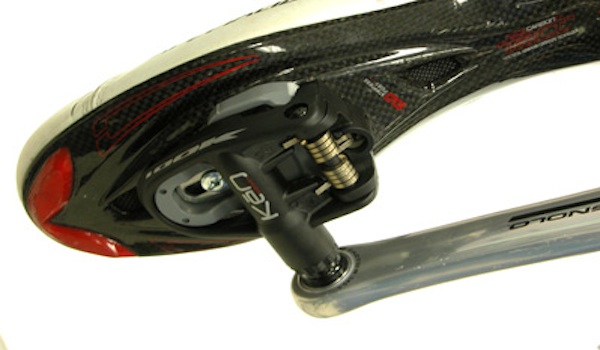 Riding clipless pedals allows you to ride further, faster, and over more technical terrain while giving you a smoother, more comfortable pedal stroke. The only real downside is falling over when you come to a stop because you forgot to unclip before stopping; more of a hit to your morale than your body. Switching to clipless pedals at the proper time along with taking the time to learn how to use them properly will take your riding up a level whether it is on the road or mountain bike.
Riding clipless pedals allows you to ride further, faster, and over more technical terrain while giving you a smoother, more comfortable pedal stroke. The only real downside is falling over when you come to a stop because you forgot to unclip before stopping; more of a hit to your morale than your body. Switching to clipless pedals at the proper time along with taking the time to learn how to use them properly will take your riding up a level whether it is on the road or mountain bike.
Timing the Switch
When you start out riding a bike you want to be focused on the riding itself, making sure you know how to shift, brake, and keep it upright and going in the direction you want without having to think about it. Adding in clipless pedals at this time just throws in another hurdle at the same time. Riders should start riding their road or mountain bike with standard flat pedals for their first ten to twenty rides. This time allows you to not only become proficient at riding but to the point that you can ride, negotiate turns, hills, and descents without having to think about it. It is already second nature to you. You need to get to this point before adding in clipless pedals otherwise they will be more challenging to learn how to use than needed.
Once you have completed ten to twenty rides on flat pedals and are extremely comfortable riding, it is time to switch to clipless pedals. You may have noticed limitations with flat pedals both on the road and mountain bike. Clipless pedals keep your foot secure in one location on the pedal as well as allowing you to pull up through the backside of the pedal stroke. This allows you to ride much more efficiently as well as with more power, specifically on climbs where your cadence slows and you’re trying to get any help you can get pushing the pedals. Also, on bumpy trails and technical climbs on the mountain bike, clipless pedals will keep your feet on the pedals, lessening the risk of them coming off and hitting your shin on the pedals, or worse, crash.
One fear that riders have in switching to clipless pedals is having their feet still engaged in the pedal in the event of a crash. One of the big benefits to clipless pedals is that they are spring loaded, like ski bindings, and when there is enough force they will disengage. The release point on most pedals can be adjusted giving you the comfort of knowing that if you do crash your feet won’t be stuck in the pedals.
Tips on Starting Out
Now that you’re comfortable on the bike and have your first set of clipless pedals and shoes, it’s time to practice to ensure that you know how they work and that you don’t fall over in front of everyone at that first red-light. The first step is to sit on your seat and lean against something so you can stay in one place while spinning the pedals backwards. The pedals work by first engaging the front part of the cleat (the piece that is attached to your shoe), on most pedal systems, and then pressing the back part of the cleat down into the pedal. A good way is to point your toes a little bit and then drop your heel. The biggest thing is lining up the cleat to the pedal itself. With practice, you will feel where your foot should fall relative to the pedal.
To clip out, simply twist the heal of your foot out and that will disengage the pedal from your cleat. Practice this with both feet multiple times until you can do it comfortably.
Now that you can comfortably clip in and out in place, it’s time to do it while riding. Starting out, find a flat to slightly downhill stretch to get rolling on. With one foot still on the ground, clip the other into the pedal and bring it to the top of the pedal stroke. Then push off with the foot that is on the ground and give a big push of the pedal with the foot that’s already clipped in. Now you will have some momentum and can now clip in your other foot. Make sure this is on a safe stretch of road or area as you won’t be paying attention to traffic but rather your feet.
Now that you have both feet clipped in and have taken a couple of pedal strokes, it’s time to unclip. While coasting put one foot down to the bottom of the pedal stroke and unclip (twisting your heel out). Now you can come to a stop and put your foot on the ground.
Now do the above again, and again, and again. You want to be comfortable finding your pedals and getting clipped in quickly as well as unclipping. Once you can do this comfortably, off you ride. During your first few rides you will have to focus on clipping in and out but once you do it enough it will become a habit and a breeze. You can now take advantage of all the benefits of having clipless pedals without any of the downsides since you practiced and are now a pro at clipping in and out.